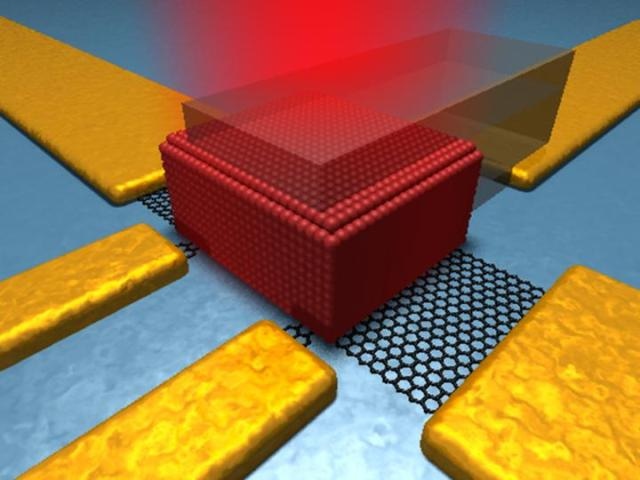Jun 21 2016
Photodetectors are used in various areas such as safety equipment, medical devices, cameras, optical communication devices, surveying instruments and many others. Due to their wide use, the improvement of photodetectors has been a highly-focused area in the last 10 years.
 This is a schematic of the device structure. (Credit ICFO)
This is a schematic of the device structure. (Credit ICFO)
A new hybrid photodetector consisting of an active colloidal quantum dot photodiode combined with a graphene phototransistor has been designed by a group of scientists at ICFO.
A lot of effort has been put into the study of optoelectronics in an attempt to develop cost-effective photodetectors that have high quantum efficiency, high levels of sensitivity, fast photoresponse, and high gain.
This development is of great significance mainly in the case of short wave infrared. At present, short wave infrared is dealt by III-V InGaAs photodetectors that are highly expensive.
Phototransistors and photodiodes are two main categories of photodetectors that have been able to meet these needs only to a certain extent even though they have a number of excellent characteristics. Phototransistors have high levels of gain and do not need low noise preamplifiers in order top be operated. Photodiodes have a greater speed that the phototransistors. However, both these classes have fallen short of fulfilling all the goals.
In an attempt to find solutions for these drawbacks, researchers at ICFO have designed a hybrid photodetector that has the potential to perform efficiently in various areas such as linear dynamic range, quantum efficiency, and speed. The research group headed by ICFO professors Frank Koppens and Gerasimos Konstantatos was made up of researchers Ivan Nikitskiy, Stijn Goossens, Dominik Kufer, Tania Lasanta and Gabriele Navickaite as its members.
Apart from functioning in the visible, the newly designed photodetector also operates in the almost infrared range of 700 to 1400 nm and in the SWIR range of 1400 to 3000 nm. In addition, the technology can be monolithically integrated with versatile electronic platforms and Si CMOS electronics. Nature Communications has presented the results of these experiments in its recent issue.
The photodetector created by the research group at ICFO has incorporated an “active” quantum dot photodiode with a graphene phototransistor in order to attain the desired effects. The addition of the active quantum dot photodiode has enabled the team to maximize the charge collection in a thick QD film with a highly absorbing feature.
This increased absorption has lead to higher quantum efficiency and increased photoresponse. Rather than depending solely on diffusion, the active quantum dot also utilizes the carrier drift in the direction of the layer of graphene to increase the efficiency of charge collection. The high carrier mobility and 2D character of the graphene transistor that the researchers merged with the scheme allowed them to catalog the bandwidth products and record the ultra-high-gains.
The capability of active quantum dot materials and graphene are indicated by the hybrid design created by the research group. The results of the experiment also open news ways for the integration of active quantum dot materials and graphene in the field of optoelectronic materials in order to improve performance and widen the range of its functions.